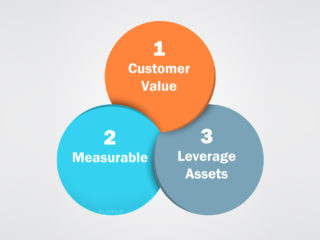
Customer Retention and Recurring Revenue Lessons from Experience
What’s your goal for investing in base marketing? Is it customer retention? Recurring revenue? In thinking back on marketing projects, I made a list of 12 high-level objectives I’ve encountered, each with numerous variations. They fall into the four broad categories of customer equity.
Content marketing to existing B2B technology customers isn’t measured in leads generated for Sales. As a program that runs parallel to the sales effort, content marketing to the customer base must drive measurable customer value (equity) and leverage marketing assets. Here’s the quick-read guide to applying three essential criteria to achieve your goals.
1. Content marketing must drive existing customer equity
We talked about the four kinds of customer equity in “Where Content Marketing Works for B2B Customer Retention.” Customers are expensive to get and most of them are worth holding onto.
Because customer equity is so important, here’s a recap of the categories in brief:
- Existing customers adopt our other products.
- Satisfied customers bring in new customers by referral.
- Long-term customers are a source of new product ideas.
- Repeat business comes at a lower transaction cost per sale.
These four categories of customer equity give us a framework for justifying investments in marketing programs to keep customers. They all lead to the bottom line: New revenue, low-cost customer acquisition, competitive product introductions, and lower costs of sales.
Let’s take the first category – existing customers adopt our other products – and consider how content marketing can be used to increase customer value through recurring revenue.
As the incumbent vendor we have ways to nurture customers through a privileged channel that the competition doesn’t have. We have more than a lead, we have a relationship.
Content marketing programs can help customers make decisions about their upcoming needs. Our privileged access gives us the opportunity to shape customers’ product expectations in our favor.
It’s that straightforward. As customers adopt more of our products, we expand our footprint in each account and, of course, we want to measure the effect.
2. Content marketing must be measured
Whatever your content marketing strategy entails, it must be measured. Take it from a career marketing manager: If it’s not measured it won’t be budgeted for long, and if it’s not budgeted it is guaranteed not to succeed.
The question is not whether content marketing can help, but how to measure its effectiveness compared to alternatives. That is done by mapping objectives to trackable metrics.
I took my previous sample list of 12 goals and thought about what metrics apply to each one. It became clear that the ideal content marketing metrics at this stage of the buying cycle would have these two key qualities:
- Metrics that measure program outcomes with a minimum of uncertainty.
- Metrics that are easily compared to alternative marketing investments.
In reality we choose a set of metrics that collectively balance these qualities. Not only do we need to attribute outcomes to content marketing with some degree of certainty, we also need to quantify a metric that can be used to evaluate other programs.
Attribution was easy early in the buying cycle, when we could use Analytics to credit demand generation to a campaign. It got more complicated as we progressed toward the close, especially for enterprise software. Post-sale, the ultimate bottom line of any metric is customer equity. Put another way, translate customer equity into meaningful metrics that can be managed.
Ideally we will be able to compare the performance of content marketing against what Marketing was doing before. That is, we should track as many future or legacy tactics as possible using the same metrics as we use to measure content marketing performance. In some cases, the return on other investments will improve as a result of customer base content marketing.
3. Content marketing should leverage marcom assets
Rarely must we start from scratch when creating content pieces for customer base programs. Any company with a reasonably sized library of content will want to reuse or repurpose existing content, rather than spending time and marketing communications budget on net new content creation.
When creating new gated content for prospects, consider giving existing customers advance access to it. Better yet, flip the sequence on its head: Create pillar pieces for your customer base and then repurpose those pieces for lead generation and lead nurturing. See whether that perspective changes how you think about content ideation.
At least do the usual: shorten, excerpt, reframe, and make spinoff pieces more relevant to users of your products.
The content marketing program that works for you will be very specific to your company’s goals. If you would like to talk about accomplishing your B2B marketing objectives, contact me and let’s see if it makes sense to work together.